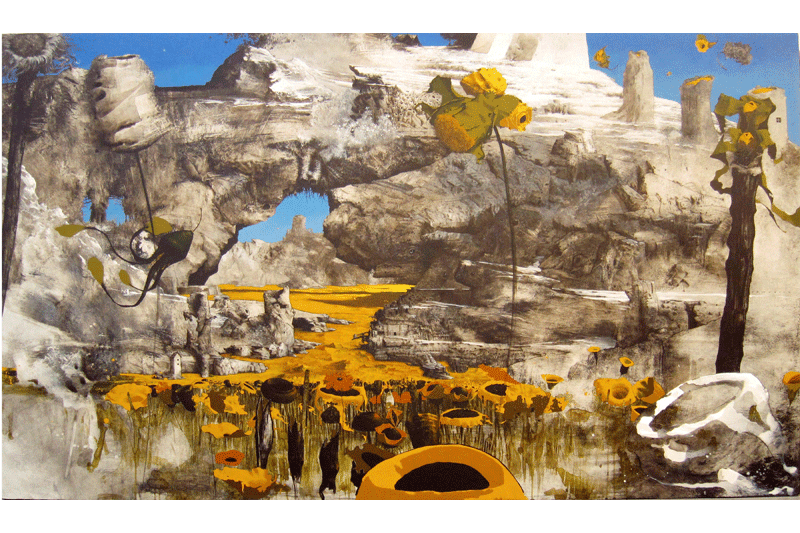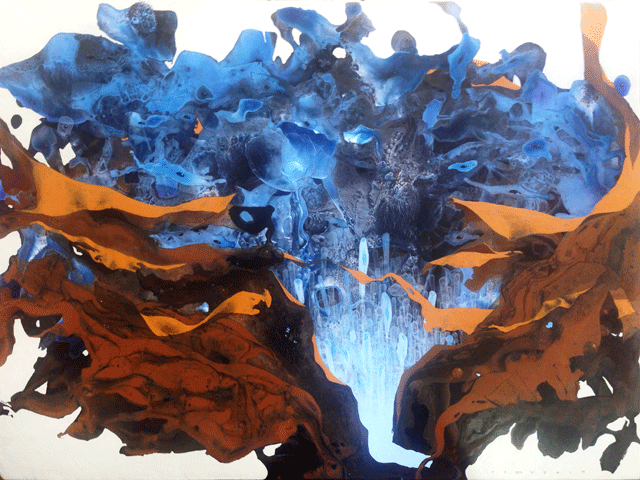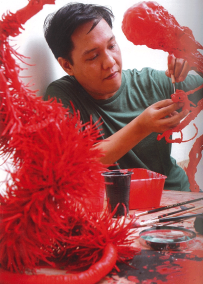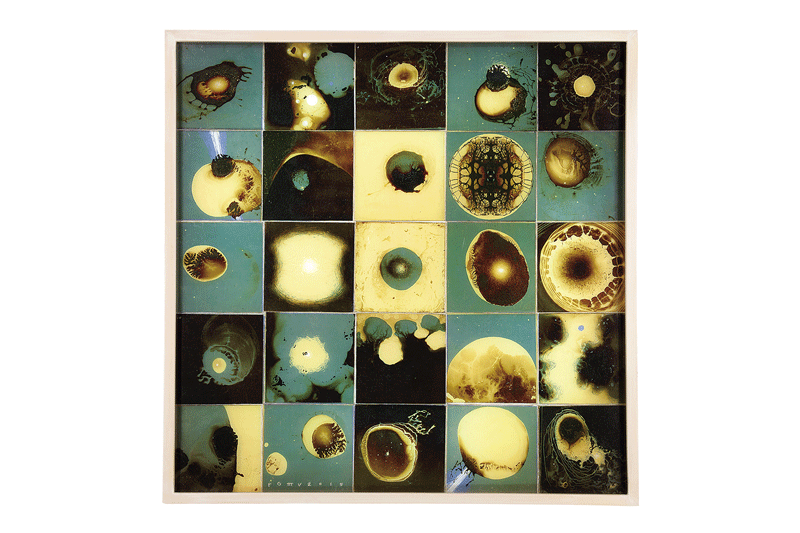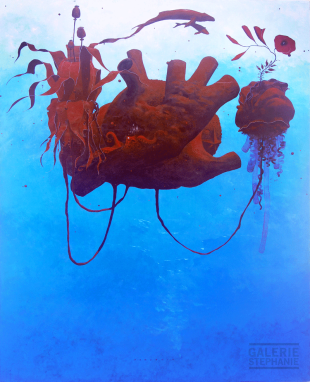On the eve of his first solo exhibition in Japan, Manila-based artist Rom Villaseran reveals the roots of his dreamlike creations.
It may be hard to remember this now—when movies set in Tolkien’s Middle-earth hit the screens six times in thirteen years, and films featuring comic book super heroes are often blockbuster season’s box-office rock stars—but works of fantasy and science fiction used to be the stuff of underground culture. Artist Rom Villaseran, a native of Manila who is preparing for a solo exhibition at Tokyo’s Kashima Arts later this month, was well steeped in this tradition from an early age.
The artist has been making a name for himself with massive canvases painted in acrylic, and smaller pencil drawings, filled with precise, hallucinatory detail. In his pieces, a giant seahorse might be found wafting its way through a rocky desert, shadowy figures can be seen lurking in abandoned structures, and the very rules of nature seem to be just recommendations rather than strict laws. His color palette ranges from muted earth tones to bold color contrasts and vibrantly saturated landscapes.
Looking on his works, you would expect that he had been heavily influenced by Surrealists and proto-Surrealists like Salvador Dali, Giorgio de Chirico, and Hieronymus Bosch. But when I asked him who his mentors were, Villaseran, who was raised on an early diet of sword & sorcery and science fiction, mentioned the names of three graphic artists—Ian Miller, Dave McKean, and Kent Williams—who walk the line between fine art and fantasy, and between comic books and the conservatory.
He adds that his origin story as an artist goes back even further, to an early emotional wound that pushed him to seek refuge within the realm of his creativity, and fired his first ambitions to start out as an artist: “It was around the time my dad left our family. It was a painful experience that pushed me into creating my own little world. I think I was around six years old when I realized that I wanted a career in art making.”
Five years later, when Villaseran was 11, his mother took him to see the “People Power” revolution in Manila, which led to the ouster of then-president Ferdinand Marcos. Although he says that no great interest in politics carries on to this day, he was struck by the protestors’ willingness to put their lives on the line for something they believed in. He commemorated the moment in a painting called “Piyesta sa Kanal” (“Feast in the Gutter”), and perhaps took some inspiration from the fervor of the demonstrators.
Not one to stay stuck in the past, he is quick to remind me that these early influences were just steps along the way: now the primary source of his inspiration are his surroundings. “Now, my inspiration comes from the natural world. I take note of how certain things in our cosmos work, then I twist it a bit to create something new. It is an endless resource.” Although Villaseran is primarily a painter and draughtsman, the University of the Philippines–trained artist also has interests in architecture, sculpture, and interior design, and a series of new pieces reveals a keen sense of observation. His three-dimensional “lightboxes,” featuring photographs and film painted with acrylic and lit from behind, depict forms that remind the viewer of some of the universe’s largest and smallest forms: exploding stars and dividing cells.
Given Villaseran’s early background and inspiration in the field of comic books and fantasy, I ask whether there is any super power he’d like to have, and the answer came back quickly: “I’d like the ability to teleport myself!” The way that things have been going for him in the past year alone, this would be an apt ability. Following a series of group and one-man shows in Manila over the past years, he began 2015 with an exhibition at Art Stage Singapore. (One of his pieces, a massive triptych titled “Dragonfly” was chosen by Forbes as one of the “must-see” works at the show.) In May, he displayed at Tokyo Art Fair, and August found him in Indonesia, for Bazaar Art Jakarta 2015. As he returns to Japan for the second time this year, he is struck by what he noticed from his fellow exhibitors at Tokyo Art Fair. “What stands out for me are Japanese artists’ attention to detail. For me, it reflects your love and respect for the work that you do. I took a lesson from that.”
The detail of Villaseran’s work is part of what gives it power, but what continues to draw the eye is the sense of sheer imagination that goes into his work, and I’m curious to know whether he launches into any of his pieces with a sense of how they will turn out. He acknowledges that he sometimes starts with an image in mind, but rather than this being a destination, it is merely a point of departure: “When I start with a particular vision, it tends to go somewhere else as I produce the piece. The vision is not the end game. It is merely the starting point. To have it as the end game makes the entire project boring to work on. It’s like reading a novel where you already know what the ending would be.”
Main Image: Ochre, 2015, 173.0cm x 101.5cm, Acrylic and graphite on canvas
Kashima Arts
Kashima Arts is located in Kyobashi, just a short walk from either Tokyo Station or the Ginza area. The building dates back to 1927, while the interior reveals a mix of modern Japanese aesthetics alongside a very traditional tea room, where you can enjoy Japanese culture with the senses.
They are known for their high quality collections of traditional Japanese painting and calligraphy from the Edo period up to the present day, including works by the renowned artist Ito Jakuchu. Also, they recently have started showing works of contemporary artists that the owner carefully selects, based on his aesthetic sense sharpened in dealing with old Japanese paintings.
In order to help foreigners to better understand Japanese arts and culture, they have English speaking staff in the gallery as well as experts to explain about works in detail. A luxurious space that takes a twist on the typical museum experience, Kashima Arts offers a truly unique experience.
Rom Villaseran’s solo exhibition “Garden in the Pond” will be held between Saturday, November 14 and Saturday, November 28. An opening reception will be held on Friday, November 13 at 6 pm. Admission to Kashima Arts is free, and opening hours are 10 am to 6 pm. For more information, visit www.kashima-arts.co.jp/en/index.html
Tel: 03-3276-0700
Sponsored Post

